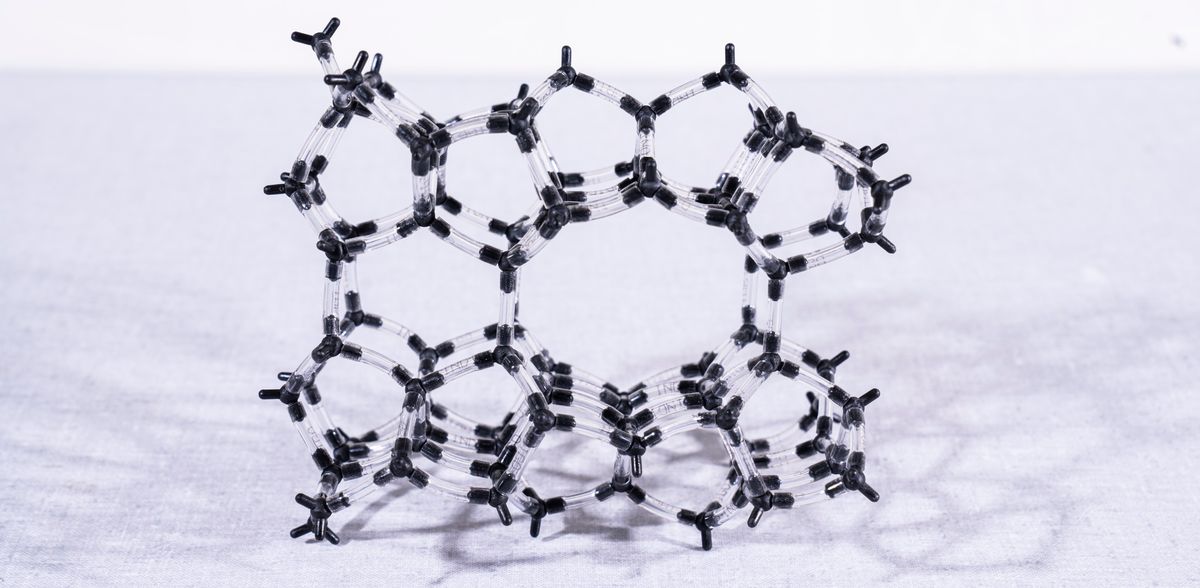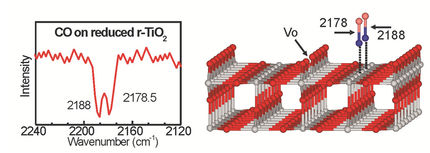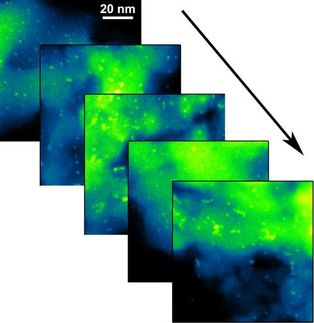How catalysts remove dangerous nitrogen oxides
”If we know exactly where the reaction takes place, the production of catalysts can be controlled accordingly”
catalysts belonging to the zeolite family help to remove toxic nitrogen oxides from industrial emissions. Researchers at the Paul Scherrer Institute PSI have now discovered that their complex nano porous structure is crucial. Specifically, individual iron atoms sitting in certain neighbouring pores communicate with each other, thereby driving the desired reaction.
Industry produces gases that are harmful to both humans and the environment and therefore must be prevented from escaping. These include nitric oxide and nitrous oxide, the latter also known as laughing gas. Both can be produced simultaneously when manufacturing fertilisers, for example. To remove them from the waste gases, companies use zeolite-based catalysts. Researchers at the Paul Scherrer Institute PSI, in collaboration with the Swiss chemical company CASALE SA, have now worked out the details of how these catalysts render the combination of these two nitrogen oxides harmless. The results of their research have been published in the journal Nature Catalysis and provide clues as to how the catalysts could be improved in the future.
An entire zoo of iron species
“The Lugano-based company CASALE contacted us because they wanted to develop a better understanding of how their catalysts used for the abatement of nitrogen oxide actually work,” says Davide Ferri, head of the Applied Catalysis and Spectroscopy research group at the PSI Center for Energy and Environmental Sciences. The zeolites used for this are composed of aluminium, oxygen and silicon atoms forming a kind of framework. Zeolites occur naturally – as minerals in rock formations, for example – or they can be manufactured synthetically. Many catalysts used in the chemical industry are based on these compounds, with additional elements added to the basic structure depending on the specific application.
When the zeolite framework also contains iron as an active substance, it enables the conversion of the two nitrogen oxides, nitric oxide (NO) and nitrous oxide(N2O), into harmless molecules. “However, these iron atoms can be located in many different positions of the zeolite framework and can possess various forms,” says Filippo Buttignol, a member of Ferri's group. He is the principal author of the new study, which he conducted as part of his doctoral thesis. “The iron can lodge in the small spaces of the zeolite in the form of single atoms, or else several iron atoms can bound together and with oxygen atoms in slightly larger spaces in the regular lattice as diatomic, multiatomic or polyatomic clusters.” In short, the catalyst contains an entire zoo of different iron species. “We wanted to know which of these iron species is actually responsible for the catalysis of nitrogen oxides.”
The researchers, who specialise in spectroscopic analyses, knew exactly which three types of experiment they needed to carry out to answer this question. They performed these while the catalytic reaction was taking place in their zeolite sample. First they used the Swiss Light Source SLS at PSI to analyse the process using X-ray absorption spectroscopy. “This allowed us to look at all the iron species simultaneously,” explains Buttignol. Next, in collaboration with ETH Zurich, they used electron paramagnetic resonance spectroscopy to identify the contribution of each species. And finally – again at PSI – the scientists used infrared spectroscopy to determine the molecular aspect of the different iron species.
Catalysis occurs at the individual atoms that communicate with each other
Each of these three methods provided one of the pieces of the puzzle that finally resulted in the following overall picture: It is the individual iron atoms located in two very specific types of zeolite pores where catalysis takes place. Two iron atoms each act together in neighbouring pores of the recurring structure: one, which sits in the centre of a square arrangement of oxygen atoms of the zeolite and where the chemical reaction of N2O takes place, communicates with another iron atom, which is surrounded by a tetrahedron-shaped oxygen arrangement and where the NO reacts.
”Only in precisely this constellation do we see contributions from the iron to the chemical elimination of the two gases,” says Buttignol. These iron atoms each gave up an electron and took it up again, i.e. the typical redox reaction of catalysis took place on them again and again. A characteristic feature of how a catalyst works is that it is not used up and is not permanently changed, but always returns to its original chemical state and therefore - at least in theory - has an unlimited lifespan.
Removing dangerous nitrogen oxides more efficiently
Ferri summarises the significance of the new study: ”If we know exactly where the reaction takes place, the production of catalysts can be controlled accordingly.”
Catalysis and thus the removal of NO and N2O from industrial exhaust air is important, as both are toxic to humans. In addition, both gases are harmful to the environment: NO is one of the causes of acid rain, while the nitrous oxide N2O is so highly climate-active that one of its molecules contributes almost 300 times more to the greenhouse effect than a molecule of CO2.
Original publication
See the theme worlds for related content
Topic World Spectroscopy
Investigation with spectroscopy gives us unique insights into the composition and structure of materials. From UV-Vis spectroscopy to infrared and Raman spectroscopy to fluorescence and atomic absorption spectroscopy, spectroscopy offers us a wide range of analytical techniques to precisely characterize substances. Immerse yourself in the fascinating world of spectroscopy!

Topic World Spectroscopy
Investigation with spectroscopy gives us unique insights into the composition and structure of materials. From UV-Vis spectroscopy to infrared and Raman spectroscopy to fluorescence and atomic absorption spectroscopy, spectroscopy offers us a wide range of analytical techniques to precisely characterize substances. Immerse yourself in the fascinating world of spectroscopy!



























































